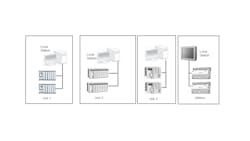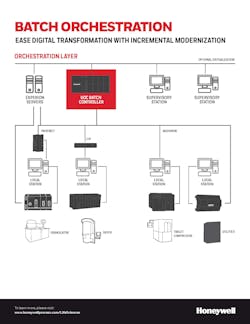Improving operational efficiency in life sciences manufacturing
Many batch manufacturing facilities have “islands of automation” where standalone units have been brought into a facility over time with limited interconnection between them for visualization or batch execution processes. As a result, issues of data silos, data integrity, paper-based processes and lack of broader operational visibility are routine.
For those wishing to address islands of automation, there are a few options. One option is to do nothing and continue to rely on paper-based processes with the potential risks around compliance, quality, data integrity and lower operational efficiency.
Another option is to layer a distributed control system (DCS) or supervisory control and data acquisition (SCADA) system on top of the existing equipment. This is often a costly and time-consuming solution that and can add a large footprint to a facility.
A third option is to implement what the industry calls a batch orchestration layer. This option leverages a plant’s existing process equipment and its built-in controllers. A Honeywell Process Orchestration Layer solution, for example, provides connectivity across skids, visibility across operations, batch historization and reporting, and electronic work instructions. It also allows contextualization of process data back to a batch ID which can support audit readiness and reduce release time.
Because a batch orchestration layer solution leverages and builds upon existing system validation, the implementation time and effort required are often reduced compared to more complex solutions.
Use case 1: Rapid startup for a large implementation
A complex project for a contract manufacturer required a solution that could flexibly address the lifecycle requirements of a large biopharmaceutical facility and a vaccine plant. The facility primarily consisted of fermentation reactors and cleaning units for use between batches produced. A large implementation demanded a solution that could scale easily and provide capabilities for agile lifecycle changes. Most importantly, the solution would need to provide the flexibility needed to accommodate design and production changes inherent to contract manufacturing organizations (CMO).
As a drug manufacturer and a CMO, product change requests from clients challenged this organization to react quickly to new production opportunities. The inability to make frequent changes to the products they produced had the potential to impact profitability and competitive differentiation. The solution relied on the Honeywell Virtual Engineering Platform (VEP) to design a scalable and flexible automation system, together with a virtualized orchestration layer which delivered the following advantages:
- Integration of third-party skids using an orchestration layer allowing direct control of any programmable logic controller (PLC)
- Physical and virtual unit operations controllers (UOCs)
- Batch execution in the process controller
- Portable processing equipment
The advantages enable this CMO to perform direct batch control to the PLC (one-on-one) without going through a third-party server running batch execution software. This saves money on hardware cost and communication time and requires less configuration by eliminating one node in the communication layer. In addition, the virtual design of the system gives the organization the ability to move to production with the physical system already qualified, significantly speeding up the validation process.
Use case 2: Supporting continuous evolution
A project for a biopharmaceutical manufacturer required a solution that could accommodate an evolution of the process control system without requiring new skid equipment. An approach using Honeywell Virtual Engineering Platform (VEP) proved to be invaluable, enabling the manufacturer to simulate the process within the design stage. Capabilities from Experion Batch were leveraged to enable an infrastructure solution that offered the following advantages:
- An orchestration layer that allows direct control of any PLC
- Virtual unit operations controller
- Distributed control
- Batch automation
- Batch visualization throughout the process
The result is a new human machine interface (HMI) that provides clear, intuitive displays to help operators better anticipate, and respond to, normal and abnormal situations. Visualization technology allows users to examine what happened historically, provides look-ahead views and predicts upcoming operator interactions — and guided troubleshooting helps them return to production with minimum downtime. Overall, visual analytics provide operations with deeper insights into upcoming events or potential delays and enables them to take on parallel tasks with confidence — knowing that there is sufficient time before the next action is required.
Ultimately the result optimizes availability, productivity and reliability. In addition, integrated support for a third-party PLC controller and an existing user interface enabled this process manufacturer to implement virtual operations without having to replace existing equipment.
Conclusion
A batch orchestration layer, or process orchestration layer, is one of the first steps an organization can take to improving process visualization across their facility. It can also serve as the first step towards digitizing dated procedures such as manual processes and logging paper-based batch records. Looking at the bigger picture, it can also help those who wish to start taking steps towards a full digital transformation of manufacturing operations.
As proven across the globe, industrial organizations can overcome competitive pressures and uncertain market conditions to achieve revolutionary business outcomes by embracing the lifecycle journey to industrial autonomy.
Industrial organizations are increasingly looking for solutions that go beyond basic automation and those within the life sciences arena are no different. They require flexible systems that can self-optimize performance across a broader network, learn from new conditions in real or near-real time and autonomously run entire production processes. These systems can operate within the four walls of the plant, but they can also connect to a global network of similar assets and even to the digital supply network more broadly.
The process industries have benefitted from industrial automation and will benefit even more with industrial autonomy. The pace of this transition is increasing with the advancement of enabling technologies such as artificial intelligence (AI), machine and deep learning, cloud and edge computing, wireless sensors and improved communications and networking.
Ultimately, the arrival at industrial autonomy in the manufacturing sector will enable every day to be the best day of production.
Shawn Opatka is vice president and GM Life Sciences at Honeywell Process Solutions. He is responsible for client success and profitability for the Life Sciences Honeywell Process Solutions portfolio. He brings over 15 years in the Life Sciences industry. His extensive experience includes identifying opportunities and technology to help improve life sciences manufacturing operations and data management challenges.
Honeywell Process Solutions




